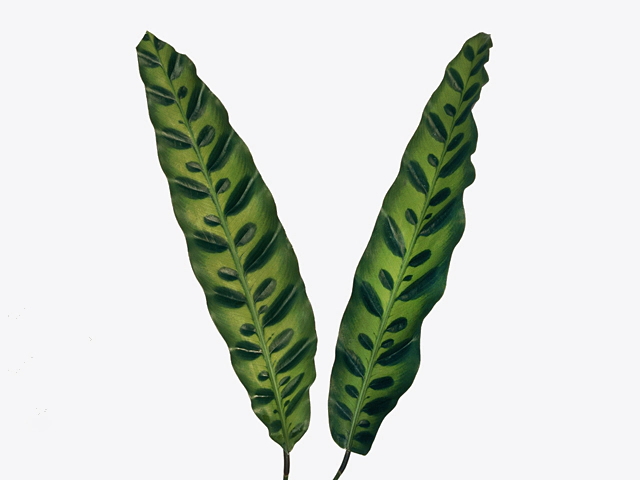Calathea lancifolia

| Flower scent | Unscented |
Calathea lancifolia, commonly known as the Peacock Plant or Rattle Snake Plant, is an exquisite tropical houseplant that is prized for its stunning foliage and unique patterns. Despite its name, the Calathea lancifolia does not boast any distinctive floral scents. Instead, its allure lies in its extravagant leaves which display a striking combination of deep green hues adorned with intricate patterns.
Native to the rainforests of Brazil, the Calathea lancifolia thrives in low-light conditions, making it an excellent choice for indoor gardening enthusiasts. Its elongated leaves feature alternating light and dark green stripes that resemble the pattern on the skin of a rattlesnake, hence its common name.
The Peacock Plant's exotic appearance adds a touch of sophistication and elegance to any space. Its large, lance-shaped leaves have gently arching silhouettes that create a sense of movement even when the plant is at rest. With proper care, the leaves can grow up to 18 inches in length, making it an eye-catching addition to any room.
One of the most appealing aspects of the Calathea lancifolia is its ability to change its leaf position throughout the day. During the day, the leaves open up, flaunting their vibrant patterns and absorbing sunlight. As the evening approaches, the leaves gracefully fold up, a behavior known as "prayer plant" movement. This unique characteristic makes it an interactive and captivating plant to observe.
Caring for the Calathea lancifolia requires replicating its natural rainforest environment as closely as possible. It thrives in moderate to high humidity levels, so misting the plant regularly or placing a humidifier nearby is highly beneficial. It prefers indirect light and should be shielded from direct sunlight, as this can damage its delicate leaves.
Furthermore, the Peacock Plant appreciates consistent moisture but should not be overwatered. Allowing the top two inches of soil to dry out between watering is a good rule of thumb. This helps prevent root rot, a common issue with Calathea plants. Using distilled water or rainwater is also recommended to avoid mineral build-up in the soil, which can harm the plant.
Fertilizing the Calathea lancifolia every two to four weeks during the growing season with a balanced, water-soluble fertilizer will help provide essential nutrients for its luscious foliage. However, it is essential to dilute the fertilizer to half or quarter strength to prevent burning the plant's sensitive roots.
When it comes to pest problems, the Peacock Plant is relatively resilient. However, it may occasionally attract pests such as spider mites or aphids. Regularly inspecting the leaves and gently wiping them with a damp cloth can help prevent pest infestations.
In conclusion, although the Calathea lancifolia may not produce any fragrant flowers, its gorgeous foliage, mesmerizing leaf movement, and ease of care make it a popular choice among plant enthusiasts. Whether you are a seasoned plant collector or a beginner looking to green up your living space, the Peacock Plant will undoubtedly add a touch of tropical beauty to your indoor garden.
Market availability index by month:
| Jan. | Feb. | Mar. | Apr. | May | Jun. | Jul. | Aug. | Sep. | Oct. | Nov. | Dec. |
|---|---|---|---|---|---|---|---|---|---|---|---|
| 3 | 3 | 3 | 3 | 3 | 3 | 4 | 3 | 3 | 3 | 3 | 2 |